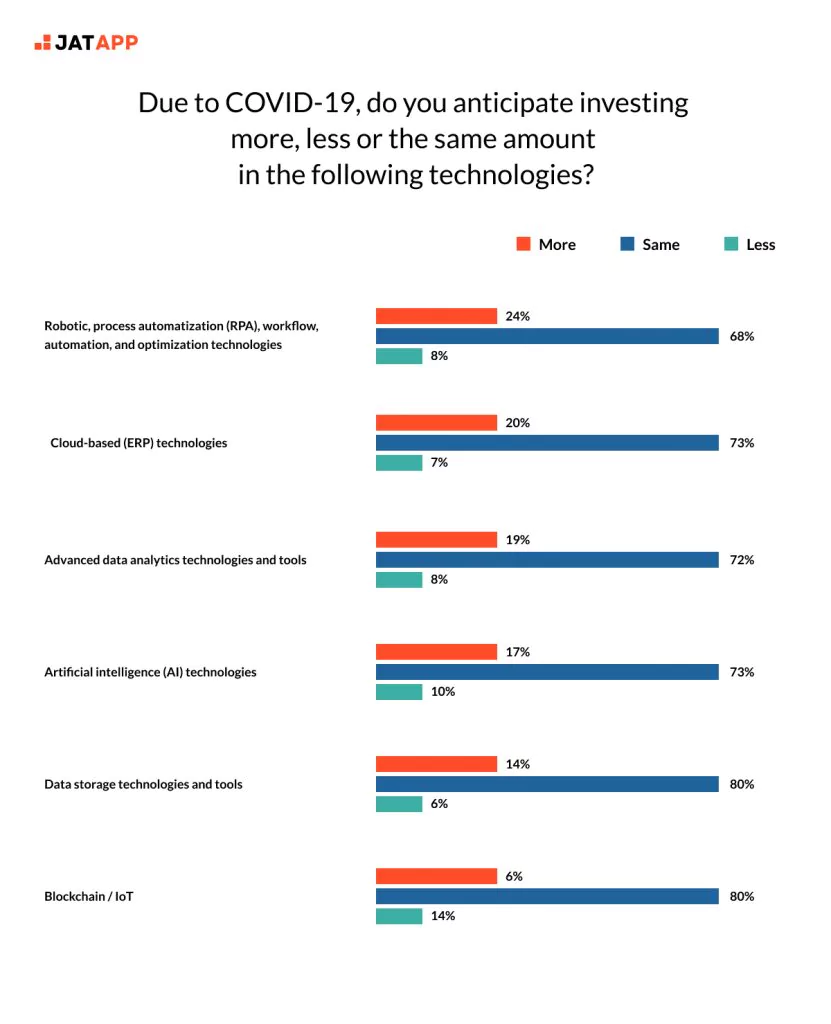The global COVID-19 pandemic had a huge impact not only on individuals but also on tech enterprises and businesses. Governmental restrictions, social distancing, and regulations inside companies immediately influenced the usual order of things: problems with supply, remote work, healthcare protection, and other issues that lead to huge losses in revenue.
The COVID-19 threat hasn’t gone anywhere, so business owners, CEOs, and other executives should come up with cost-saving strategies to make sure that the business remains viable and profitable.
For more than 8 years, JatApp has been at the forefront of assisting both local and international companies to reduce IT costs. The profound experience helped us to come up with the best strategies for managing and optimizing IT and operational costs. And we decided to share them with you!
In the article below, we’ll discuss six IT ideas that will help to reduce costs and to minimize the negative influence of the COVID-19 crisis on the business.
We believe that setting up teams, where CIOs would work hand-in-hand with other business units may greatly help to implement IT cost optimization strategies and to significantly improve the performance. When monitoring the business environment, you may need to choose either strategy, which should be implemented without any delays and strategies, which require detailed planning and think over.
Businesses should have a clear understanding of what the difference between cost optimization and cost-cutting is. While the last assumes improving the strategy, in the long run, the second means immediate response to the situation by rationalizing or eliminating costs. The next equally important term is value optimization, which is widely used by cost-reduction managers. It offers to increase business value through constant analysis, prioritization, and continuous innovations.
In total, international IT spending in 2020 is thought to estimate around $3,4 trillion, which is 8% lower than in 2019. Seeing the general picture allows businesses to avoid the biggest IT cost reduction mistakes: an increasing share of shadow IT, not being able to reintroduce costs, etc.
Thus, you are able to analyze the way the money is spent in your departments by paying attention to the following factors: team, software, hardware, facilities, contractors, and supplies. Every category should remain flexible and open to changes. According to McKinsey, up to 30% of IT, expenditures may be saved simply by applying strategies, which improve the flexibility and mobility of the departments.
Remembering about these issues, you’ll be able to come up with the best solution and to decide which problems can be fixed at once and which require analysis and planning. There’s no universal solution for each of the problems, so we offer you a list of the best cost reduction strategies, which can be applied in different categories.
Six cost reduction ideas for IT that really work
1. Upgrade your company’s IT paying attention to security
Modern enterprises are paying closer attention to their IT departments and architecture potential in order to avoid any issues related to security, mobility, and scalability. And no wonder: these issues may significantly increase the company’s expenses.
It’s rather challenging to maintain a business on a regular level if the technical infrastructure is not able to adjust to constantly changing environments. When the COVID-19 hit, many workers had to stay at home and complete routine tasks remotely. Thus, to maintain a good level of productivity, the IT infrastructure had to be changed.
Businesses, which utilize private data centers, conduct VPN tests to check if their infrastructure is capable of withstanding a rapid increase in users. This especially concerns remote workers, who are connecting from different locations. Some companies, which use the cloud, are trying to find out a way to cut cloud costs and to adjust to a new state of affairs.
If a solid technical infrastructure is absent, the risks of security problems significantly increase. You may experience compliance and contractual violations, malware, hacker attacks, unintentional errors, weak APIs, and much more.
That is why businesses must invest in expensive and modern security. Even though you may have to spend more, integrating security throughout all stages of the development process will eventually help to reduce costs.
2. Revise your expenditures on cloud computing
The majority of enterprises, which already use the cloud, are in a constant search of the ways to reduce costs on it. And if you lack knowledge in the field, the best way is to hire a professional company. Here are some of the most popular and viable approaches to optimize cloud expenditures:
- Spending more on reserved instances;
- Using instances on demand;
- Benefiting from discounts and promotions that cloud providers regularly offer;
- Entrusting this process to providers instead of spending lots of time and resources to complete the task on your own.
3. Support working remotely
To comply with quarantine requirements, many companies, especially in the tech field, had to switch to a remote mode. If such businesses continue to business IT support service working from home after the COVID-19 restrictions are canceled, this may save lots of money spent on supplies, rent, and maintenance.
This cost reduction strategy is very simple and easy to implement because many businesses have already switched to the new reality and have changed the working process to adjust to working from home.
4. Spend money on automation
As we have already discussed, cost reduction doesn’t only mean cutting expenditures. It also means investing in creating an effective environment even though many companies are freezing investments due to the pandemic crisis, going digital plays a crucial part in development, especially considering that competitors constantly speed up automation.
According to the latest surveys, the areas with the maximum investments are robotic and workflow automation, as well as cloud-based technologies.
It’s difficult to underestimate automation because it is able to solve multiple problems. It not only deals with day-by-day tasks in an accurate manner but also performs challenging processes, which reduce costs and improve the systems.
However, it doesn’t mean that automation is able to replace people. Actually, blending the latest technologies and people will strengthen the potential of your team. It will improve their skills and will motivate workers to learn and evolve.
5. Carefully implement cost reduction strategies that concern staff
It’s not surprising that the most challenging cost reduction practice concerns the workforce. Especially during the pandemic and the complex financial conditions, many people are in. Unfortunately, many enterprises don’t have any other options than to freeze salaries and travel/entertainment, delay or cancel new job offers, lower salaries, lay off workers, and so on.
We advise considering the long-term impact such decisions may have. For example, the hired team members may actually be the most valuable workers, and they are those who possess core knowledge and skills. That is why the main goal is to do everything possible to make all the workers stay.
As a bonus, such an approach will help with building a favorable employer brand picture, which will boost the interest to your company once the quarantine ends. Before firing workers, the business must consider a variety of options, which can potentially reduce workforce expenditures. They include cutting salaries, lowering the workload, re-training workers, non-paid vacations, etc.
Unfortunately, there are cases when letting the employee go in inevitable. We recommend making the process clear and as positive as possible. Don’t forget to keep in touch with the workers because you may want to hire them when the crisis ends.
According to the research, half of the senior executives plan to hire before increasing other costs. After hiring, they want to return capital expenditure and travel and entertainment costs.
6. Reconsider the IT outsourcing cooperation
One of the best cost reduction ideas during the pandemic is outsourcing software development processes. Even before the quarantine, this was a rather popular solution for business. However, during the lockdown, this strategy is a lifesaver for companies, which are deciding how to cut costs on development.
The Telegraph claims that companies are able to save 30% on operating costs simply by outsourcing the tasks. It is also a great idea for solving urgent questions during the quarantine because there’s no need to wait while everyone returns to the office.
In case you already have IT, outsourcing associates, it’s time to analyze the contracts and apply certain measures:
– Ensure that all employees of the partner can work effectively during the lockdown;
– Make sure that the team applies security protocols when working from home;
– Create a capacity rebalancing plan;
– Discuss rates and salaries if necessary;
– Ensure that the provider guarantees infrastructure and hardware services without any interruptions.
If your outsourcing partner can’t meet the requirements above, we recommend searching for another provider. At the moment, Easter Europe and Asian countries have first-class specialists that are able to work remotely. However, Eastern Europe turned out to be more prepared for the pandemic and crisis. For example, in the Philippines, where the lockdown restrictions are extremely harsh, up to 50% of the projects and outsourcing tasks are not performed. In case you don’t have outsourcing partners abroad but are willing to try, our specialists will help with choosing the right company.
Here are only some of the reasons why partnering with JatApp in IT outsourcing is a great idea:
– More than 8 years of experience working remotely and managing distributed teams. Over 5 years we have been cooperating with the leading global businesses;
– JatApp is a reputable name on the international IT market: we were listed as one of the leading software providers by Clutch and were called one of the leading software developers according to GoodFirms.co, and other well-known resources;
– Our work is built on the agile approach, which ensures the flexibility and efficiency of every process. We immediately adapt to the constant changes and aim to find the best solution in every particular case;
– We help business in a variety of fields: mobile and web development, infrastructure configuration, automation, shifting to the cloud, etc.;
– Our company offers a Discovery Phase, which aims to lessen the risks, optimize available resources, and decrease development costs;
– JatApp team developers scalable and secure solutions in a wide variety of industries and markets, including telecom, logistics, industrial manufacturing, healthcare, and others.
Final thoughts
Many companies and businesses, both locally and internationally, have switched to cost-saving practices in IT while facing the lockdown and the coronavirus crisis. However, the trick here is that these practices and strategies should be spontaneous or thoughtless. CEOs should cooperate with stakeholders, financial experts, and executives to create an efficient. IT cost reduction strategy, which would be tailored to your particular case.
We recommend creating a unique approach for every goal and problem. For example, upgrading IT security, moving to the cloud, support remote workers, increasing the automation budget, trying to avoid firing employees, cooperating with IT outsourcing companies, and much more. After applying these strategies, you’ll see that your enterprise is able to withstand even the most complex situation and to continue growing despite the quarantine and lockdown.
In order to reduce costs effectively and not to harm the business, you should apply planned and timely measures. Thus, the business will have all the chances to survive and to adapt to the modern reality.






